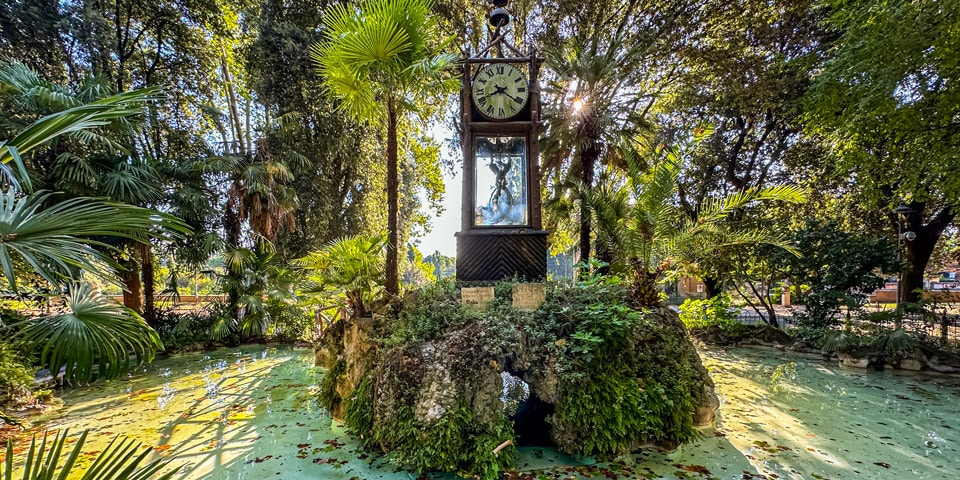

24870 views
Written by: Artur Jakucewicz

| Closest bus stops |
|
|---|---|
| Closest subway stations |
|
| Address | Viale dell'Obelisco, a39, Roma |
Rome’s Water Clock is nestled in the park of Villa Borghese and is just a stone’s throw from Pincio’s panoramic terrace. An exquisite fusion of engineering and aesthetics, it remains a timeless marvel and testament to human ingenuity.
Contents
ToggleThe water clock was conceived in 1867 by Giovanni Battista Embriaco, a Dominican friar with Ligurian roots. A passionate lover of clocks and engineering, Embriaco built his first clock at the age of 17. His passion culminated in creating the Water Clock, a model he sent to the Universal Exhibition of Paris in 1867. Unfortunately, the clock remained unopened in its packaging due to the fear of breaking it and technical difficulties.
The actual construction of the water clock at Pincio Hill was undertaken by the Granaglia brothers from Turin. It was installed in 1873, opening the magical world of timekeeping to Romans and tourists alike.
Standing on an islet in the center of a small lake in Villa Borghese, the clock rests on a cast-iron base above stones. It’s about four meters tall, and each side features glass panes with glass dials positioned above, showing Roman numerals and brass hands.
The clock’s structure beautifully mimics tree trunks, seamlessly blending into the natural surroundings. A wooden bridge leads to the clock, enveloped by lush vegetation and the serene silence of the beautiful park. Gioacchino Ersoch, an architect of Rome, chose this picturesque setting and decided to position the clock atop a mass of artificial rocks.
The water clock, or Hydrochronometer, functions with water as its principal engine.
A jet of water alternatively fills one of the two elongated leaf-shaped basins, oscillating like a balance’s arms. This movement activates the mechanism that turns the hands, marking the time. Additionally, the water flow charges the chime mechanism, creating an engineering marvel.
Read also about Borghese Gallery.
Over the years, the clock faced deterioration due to weather. However, since 2004, the Professional Training School of the ELIS Center (www.elis.org) has been maintaining its maintenance. A recent inspection on June 3, 2021, confirmed that the clock is in working condition.
The clock’s unique nature and artistic and decorative qualities have always sparked interest and curiosity. It’s considered a “unicum” since no other examples of water clocks are placed in public gardens.
In an era where digital technology often overshadows traditional craftsmanship, the Water Clock of Pincio stands as a tribute to timeless innovation and beauty. Its silence, broken only by the flowing water, the wooden bridge, and the rocky and lush islet on which the clock stands, all transport visitors into a magical, timeless dimension—a paradox considering the very nature of the object.
As the Director of the ELIS School, Pierluigi Bartolomei, stated, the restoration and ongoing care of the water clock are driven by passion and a desire to leave a trace. It serves as a lasting symbol of Rome’s cultural heritage, captivating the imagination of tourists and locals alike and reminding us of the intrinsic link between art, nature, and time.
Read also about Ancient Park of the Aqueducts.
The easiest way to find the water clock at Villa Borghese (here are the coordinates on Google Maps) is to use the Pincio viewpoint as a guide. The easiest way to find the water clock at Villa Borghese is to use the Pincio lookout as a guide. Turn around 180 degrees so that the view of the dome of Peter’s Cathedral in the Vatican is behind you. Walk about 3 minutes past a lone palm tree and a Fountain of Moses.
Congratulations! You have arrived at an engineering marvel and one of Rome’s not-so-banal sights.
Author: Artur Jakucewicz
This website uses cookies. For more info read the cookies policy
Rome.us © 2025. Created with love by Roman experts and guides.